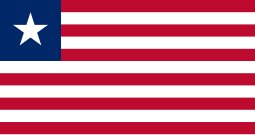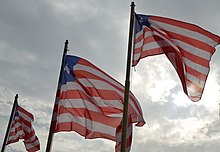Flag of Liberia
It has been suggested that List of Liberian flags be merged into this article. (Discuss) Proposed since March 2024. |
 | |
| Use | National flag and ensign |
|---|---|
| Proportion | 10:19 |
| Adopted | 24 August 1847 |
| Design | Eleven horizontal stripes alternating red and white; in the canton, a white star on a blue field |
| Designed by | Susannah Elizabeth, Matilda Newport, Rachel Johnson, Mary Hunter, Sarah McGill Russwurm, Colonette Teage Ellis and Sara Draper |
 | |
| Use | Naval jack |


The flag of Liberia, occasionally referred to as the Lone Star,[1][2] bears a close resemblance to the flag of the United States, representing Liberia's founding by former black slaves from the United States and the Caribbean.[3] They are both part of the stars and stripes flag family.
The Liberian flag has similar red and white stripes, as well as a blue square with a white star in the canton. It was adopted on 24 August 1847.[4][5]
History
[edit]On 9 April 1827, a resolution was made establishing the first flag of Liberia, during its time as a colony, which identified the flag the same as the United States, except with a white cross in the place of the canton’s stars.[6] In preparation for independence, the flag of Liberia was redesigned and hand-stitched by a committee of seven women.[1] Governor Joseph Jenkins Roberts, in a letter dated 10 July 1847, asked Susannah Elizabeth Lewis to head the committee.[7] The other members of the committee were Matilda Newport, Rachel Johnson, Mary Hunter, Mrs. Sarah McGill Russwurm (wife of J. B. Russwurm), Colonette Teage Ellis, and Sara Draper. All of the women were born in the United States, and many of them were wives of prominent men in Liberia.[1][8] Lewis was the daughter of former vice colonial agent Colston Waring, the sister of the first First Lady of the Republic, Jane Roberts, and wife of John N. Lewis, one of the signers of the Liberian Declaration of Independence.[9][10][11] The flag they designed was adopted on 24 August 1847, about a month after Liberia had declared independence on 26 July 1847.[1] The day the flag was adopted, the nation held a celebration in Monrovia. There, the flag was unfurled to the public for the first time, and Susannah Lewis gave a patriotic speech. The ceremony also featured speeches by a number of notable Liberian politicians and religious leaders, as well as entertainment in the form of band music.[12]
In the 1850s and 1860s, the Eusibia N. Roye became the first Liberian-owned ship to display the flag in New York City and Liverpool ports. The vessel was owned by Edward James Roye.[13] In 1860, the Liberian flag was featured on the first known stamp to be issued by the Liberian government.[14] On 24 October 1915, President Daniel Edward Howard signed into law an act which proclaimed 24 August as Flag Day, a national holiday.[1]
On 22 July 1974, the Legislature of Liberia passed an act giving authorization to the president to establish a commission to give consideration to possible changes to a number of national symbols, including the flag and national anthem. The commission was headed by McKinley Alfred Deshield Sr. The commission sought to reexamine the symbols, and remove divisive aspects of them. President William Tolbert appointed 51 members to the Commission on National Unity. The commission was also called the Deshield Commission, after the man who headed it. The commission submitted their report on 24 January 1978. The report ultimately recommended no changes to the flag.[15]
In 2022, a new design for the five-hundred-dollar Liberian banknote featured an illustration of the seven-woman committee designing the Liberian flag.[16]
The flag is seen on many ships around the world as Liberia offers registration under its flag. Shipping companies do this to avoid taxes and restrictions that other countries enforce. As the second most popular flag of convenience (after the flag of Panama), it is estimated that 1,700 foreign-owned ships fly the Liberian flag.[17] This brings in much of the country's revenue.[18]
Symbolism
[edit]The eleven stripes symbolize the signatories of the Liberian Declaration of Independence and the red and white symbolize courage and moral excellence. The white star represents the first independent republic in Africa, above the blue square representing the African continent. The Liberian flag is modeled after and resembles the United States flag because Liberia was founded, colonized, established, and controlled by free people of color and formerly enslaved Black people from the United States and the Caribbean with the help and support of both the United States government and the American Colonization Society (ACS), a private organization dedicated to the removal of free people of color from across North America. Some time after the African Americans began arriving in Liberia in 1822, they came to be identified as "Americo-Liberians" in an effort to separate them from native groups and enslaved Africans rescued from illegal slaving ports and ships by the U.S. Navy.[18]
Construction
[edit]Keep the length 110 units and width as 209 units. The canton's each side is 50 units, the circumscribed square of the 5-point star has all sides 30 units and its center is 25 units from the left and upper edge of the flag of the canton/flag.[citation needed]
Other flags
[edit]-
Flag of the Liberian Customs Service
-
Standard of the president of the Republic of Liberia
-
 Flag of the United States (1837–1845), with 26 stars / states was used in the first government of the Commonwealth of Liberia until Saturday, 26 April 1845
Flag of the United States (1837–1845), with 26 stars / states was used in the first government of the Commonwealth of Liberia until Saturday, 26 April 1845 -
 Flag of the Colony of Liberia (1827-1847)
Flag of the Colony of Liberia (1827-1847) -
 Flag of the Republic of Maryland from 1854 to 1857
Flag of the Republic of Maryland from 1854 to 1857
County flags
[edit]Liberia is subdivided into 15 counties, each of which is entitled to its own flag. Each county flag bears the national flag of Liberia in the canton. The county flags are flown at regional offices and together encircling the national flag of Liberia at the Executive Mansion.
The flags were introduced in 1965 by William Tubman for the purpose of promoting the counties as meaningful entities.[20] Their design was inspired by Liberia's quilting tradition.
The flags (particularly River Gee County) have been the subject of widespread ridicule by members of online vexillology communities on social media platforms such as Reddit and Facebook. However, vexillologist Steven A. Knowlton argues that these discussions demonstrate a lack of understanding of the political and cultural context of the flags and of the material construction of flags from textiles as opposed to digital creation.[21]
-
Flag of Bomi County
-
Flag of Bong County
-
Flag of Gbarpolu County
-
Flag of Grand Bassa County
-
Flag of Grand Cape Mount County
-
Flag of Grand Gedeh County
-
Flag of Grand Kru County
-
Flag of Lofa County
-
Flag of Margibi County
-
Flag of Maryland County
-
Flag of Montserrado County
-
Flag of Nimba County
-
Flag of Rivercess County
-
Flag of River Gee County
-
Flag of Sinoe County
See also
[edit]References
[edit]- ^ a b c d e "Liberia: Flag Day Reflections - All Hail the Lone Star, All Hail!". AllAfrica. 27 August 2019. Retrieved 8 July 2021.
- ^ Rozario, Paul (2003). Liberia. Gareth Stevens. p. 5. ISBN 9780836823660.
- ^ "Background on conflict in Liberia". Archived from the original on 5 November 2007.
Paul Cuffee advocated settling formerly enslaved African Americans in Africa. He gained support from free black leaders in the US, and members of Congress for an early emigration plan. From 1815 to 1816, he financed and captained a successful voyage to British-ruled Sierra Leone, where he helped a small group of African-American immigrants establish themselves. Cuffee believed that African-Americans could more easily "rise to be a people" in Africa than in the US, where slavery and legislated limits on black freedom were still in place. Although Cuffee died in 1817, his early efforts to help repatriate African-Americans encouraged some free blacks and the American Colonization Society (ACS) to lead further settlements. Some free blacks in the Upper South created independent institutions dedicated to the idea of repatriation to Africa. The ACS was made up mostly of Friends (often called Quakers) and slaveholders, who disagreed on the issue of slavery but found common ground in support of repatriation. Friends opposed slavery but believed blacks would face better chances for freedom in Africa than in the US. The White Americans slaveholders opposed freedom for blacks but saw repatriation as a way of avoiding rebellions
- ^ Liberia: Open Door to Travel and Investment. Liberia. Department of Information and Cultural Affairs. 1967. p. 19.
This symbol of Negro liberty was first unfurled on August 24, 1847
- ^ "Liberia Flag and Description". 24 February 2021.
- ^ Smith, Whitney. "flag of Liberia". Encyclopedia Britannica. Retrieved 10 June 2023.
- ^ de Graaf, G. "Flags Over Liberia" (PDF). International Congress of Vexillology. pp. 123–124. Retrieved 10 June 2023.
- ^ Burrowes, Carl Patrick (2004). Power and Press Freedom in Liberia, 1830-1970. Africa World Press. p. 97. ISBN 9781592212941.
- ^ Gates, Henry Louis and Evelyn Brooks Higginbotham (2008). The African American National Biography: Moore, Lenny-Romain. Oxford University Press. pp. 620–621. ISBN 978-0-19-516019-2.
- ^ American Colonization Society (1873). The African repository and colonial journal 49. pp. 336–337.
- ^ Richardson, Nathaniel R. (1959). Liberia's Past and Present. Diplomatic Press and Publishing Company. p. 73. ISBN 9780608329321.
- ^ Burrowes, Power and Press Freedom in Liberia, 1830-1970, pp. 59–60.
- ^ Dunn, Elwood D.; Beyan, Amos J.; Burrowes, Carl Patrick (2000). Historical Dictionary of Liberia. Scarecrow Press. p. 127. ISBN 9781461659310.
- ^ Dunn; Beyan; Burrowes; Historical Dictionary of Liberia, pp. 308.
- ^ Dunn; Beyan; Burrowes; Historical Dictionary of Liberia, pp. 107–109.
- ^ "Liberia Issues New Banknotes: $20, $50, $500, and $1,000". Keesing Technologies. October 13, 2022. Retrieved September 28, 2023.
- ^ "Liberian shipping draws scrutiny". NBC News. 11 August 2003. Archived from the original on October 20, 2020.
- ^ a b "Liberia Flag- Liberian Flags". World Flags 101. Archived from the original on 4 November 2018.
- ^ "The flag of Liberia".
- ^ Dunn, D. Elwood, ed. (2011). The annual messages of the presidents of Liberia 1848-2010: state of the nation addresses to the National Legislature: from Joseph Jenkins Roberts to Ellen Johnson Sirleaf. Berlin ; New York: De Gruyter. p. 1308. ISBN 978-3-598-22600-7.
- ^ Knowlton, Steven A. (2021). "Liberian County Flags in Historical and Cultural Context" (PDF). Raven: A Journal of Vexillology. 28: 57–90.






![Flag proposed by Harry Johnston in 1906[19]](http://upload.wikimedia.org/wikipedia/commons/thumb/6/6d/Flag_of_Liberia_%281906_proposal%29.svg/120px-Flag_of_Liberia_%281906_proposal%29.svg.png)














